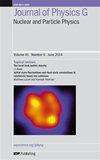Revisiting proton-proton fusion in chiral effective field theory
IF 3.5
3区 物理与天体物理
Q2 PHYSICS, NUCLEAR
Journal of Physics G: Nuclear and Particle Physics
Pub Date : 2023-04-06
DOI:10.1088/1361-6471/ace3e2
引用次数: 0
Abstract
We calculate the $S$-factor for proton-proton fusion using chiral effective field theory interactions and currents. By performing order-by-order calculations with a variety of chiral interactions that are regularized and calibrated in different ways, we assess the uncertainty in the $S$-factor from the truncation of the effective field theory expansion and from the sensitivity of the $S$-factor to the short-distance axial current determined from three- and four-nucleon observables. We find that $S(0)=(4.100\pm0.019\mathrm{(syst)}\pm0.013\mathrm{(stat)}\pm0.008(g_A))\times10^{-23}~\mathrm{MeV\,fm}^2\,,$ where the three uncertainties arise, respectively, from the truncation of the effective field theory expansion, use of the two-nucleon axial current fit to few-nucleon observables and variation of the axial coupling constant within the recommended range. The increased value of $S(0)$ compared to previous calculations is mainly driven by an increase in the recommended value for the axial coupling constant and is in agreement with a recent analysis based on pionless effective field theory.手性有效场论中质子-质子聚变的再认识
我们使用手性有效场论相互作用和电流计算质子-质子聚变的$S$因子。通过对以不同方式正则化和校准的各种手性相互作用进行逐阶计算,我们评估了有效场论展开式截断后的$S$因子的不确定性,以及$S$因子对由三个和四个核子可观测值确定的短距离轴流的灵敏度。我们发现$S(0)=(4.100\pm0.019\mathrm{(syst)}\pm0.013\mathrm{(stat)}\pm 0.008(g_A))\times10^{-23}~\mathrm{MeV\,fm}^2 \,$,其中三个不确定性分别来自于有效场论展开的截断、对少数核子可观察性的两个核子轴向电流拟合的使用以及轴向耦合常数在推荐范围内的变化。与之前的计算相比,$S(0)$的增加值主要是由轴向耦合常数的推荐值的增加驱动的,并且与最近基于无π有效场论的分析一致。
本文章由计算机程序翻译,如有差异,请以英文原文为准。
求助全文
约1分钟内获得全文
求助全文
来源期刊
CiteScore
7.60
自引率
5.70%
发文量
105
审稿时长
1 months
期刊介绍:
Journal of Physics G: Nuclear and Particle Physics (JPhysG) publishes articles on theoretical and experimental topics in all areas of nuclear and particle physics, including nuclear and particle astrophysics. The journal welcomes submissions from any interface area between these fields.
All aspects of fundamental nuclear physics research, including:
nuclear forces and few-body systems;
nuclear structure and nuclear reactions;
rare decays and fundamental symmetries;
hadronic physics, lattice QCD;
heavy-ion physics;
hot and dense matter, QCD phase diagram.
All aspects of elementary particle physics research, including:
high-energy particle physics;
neutrino physics;
phenomenology and theory;
beyond standard model physics;
electroweak interactions;
fundamental symmetries.
All aspects of nuclear and particle astrophysics including:
nuclear physics of stars and stellar explosions;
nucleosynthesis;
nuclear equation of state;
astrophysical neutrino physics;
cosmic rays;
dark matter.
JPhysG publishes a variety of article types for the community. As well as high-quality research papers, this includes our prestigious topical review series, focus issues, and the rapid publication of letters.

 求助内容:
求助内容: 应助结果提醒方式:
应助结果提醒方式:


